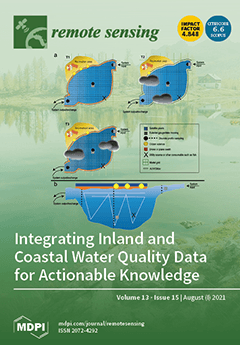This study investigates the uncertainties associated with estimates of the long-range transport SO
2 (LRT-SO
2) flow rate calculated hourly using Geostationary Environment Monitoring Spectrometer (GEMS) synthetic radiances. These radiances were simulated over the Korean Peninsula and the surrounding regions using inputs from the GEOS-Chem model for January, April, July, and October 2016. The LRT-SO
2 calculation method, which requires SO
2 vertical column densities, wind data, and planetary boundary layer information, was used to quantify the effects of the SO
2 slant column density (SCD) retrieval error and uncertainties in wind data on the accuracy of the LRT-SO
2 estimates. The effects were estimated for simulations of three anthropogenic and three volcanic SO
2 transport events. When there were no errors in the GEMS SO
2 SCD and wind data, the average true LRT-SO
2 flow rates (standard deviation) and those calculated for these events were 1.17 (
0.44) and 1.21 (
0.44) Mg/h, respectively. However, the averages of the true LRT-SO
2 flow rates and those calculated for the three anthropogenic (volcanic) SO
2 events were 0.61 (1.17) and 0.64 (1.20) Mg/h, respectively, in the presence of GEMS SO
2 SCD errors. In the presence of both errors in the GEMS SO
2 SCD and wind data, the averages of the true LRT-SO
2 flow rates and those calculated for the three anthropogenic (volcanic) SO
2 events were 0.61 (1.17) and 0.61 (1.04) Mg/h, respectively. This corresponds to differences of 2.1% to 23.1% between the simulated and true mean LRT-SO
2 flow rates. The mean correlation coefficient (R), intercept, and slope between the true and simulated LRT-SO
2 flow rates were 0.51, 0.43, and 0.45 for the six simulated events, respectively. This study demonstrates that SO
2 SCD accuracy is an important factor in improving estimates of LRT-SO
2 flow rates.
Full article





